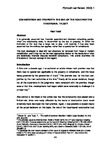Cohabitation and Property: The End of the Road for the Traditional Trust?
| dc.contributor.author | Todd, Paul | |
| dc.date.accessioned | 2017-03-27T15:49:54Z | |
| dc.date.accessioned | 2017-04-11T11:08:10Z | |
| dc.date.available | 2017-03-27T15:49:54Z | |
| dc.date.available | 2017-04-11T11:08:10Z | |
| dc.date.issued | 2008 | |
| dc.identifier.citation |
Todd, P. (2008) 'Cohabitation and Property: The End of the Road for the Traditional Trust?', Plymouth Law and Criminal Justice Review, 1, pp. 101-117. Available at: https://pearl.plymouth.ac.uk/handle/10026.1/8943 | en_US |
| dc.identifier.issn | 2054-149X | |
| dc.identifier.uri | http://hdl.handle.net/10026.1/8943 | |
| dc.description.abstract |
It is generally assumed that financial apportionment between cohabiting parties, when the relationship ends, is determined by the law of property, in which the institution of the trust has a large role to play. Until recently, it has also been assumed that the ordinary law applies, rather than a special law for cohabitants. The trust developed to deal with fact situations far removed from those of modern cohabitation, and it may not be the most appropriate device for the resolution of what are essentially financial disputes between cohabitants. This article examines the limitations of the trust concept in this regard. | en_US |
| dc.language.iso | en | en_US |
| dc.publisher | University of Plymouth | |
| dc.rights | Attribution 4.0 International (CC BY 4.0) | * |
| dc.rights.uri | https://creativecommons.org/licenses/by/4.0/ | * |
| dc.title | Cohabitation and Property: The End of the Road for the Traditional Trust? | en_US |
| dc.type | Article | en_US |
| dc.type | Article | |
| plymouth.volume | 1 | |
| plymouth.journal | The Plymouth Law & Criminal Justice Review |



